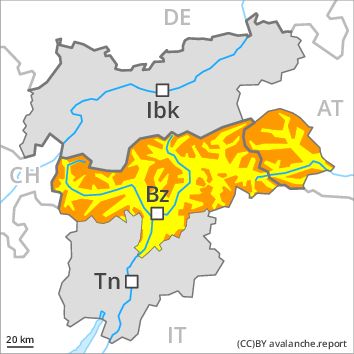Regions
Sexten Dolomites, Val Müstair Alps, Langtaufers, Schnals Ridge, Southern Stubai Alps, Southern Zillertal Alps and High Tauern, Saldurn-Mastaun Ridge, Texel Mountains, Sarntal Alps, Western Pfunderer Mountains, Eastern Pfunderer Mountains, Durreck Range, Western Rieserferner Mountains, Western Deferegger Alps, Ortler Range, Ulten Valley, Venediger Range, Eastern Nonsberger Alps, Eastern Rieserferner Mountains, Northern Dolomites of Fiemme, Glockner Range, Gröden Dolomites, Eastern Deferegger Alps, Prags Dolomites, Schober Mountains, Lienzer Dolomites

Danger level
Avalanche Problem
Wind-drifted snow above the treeline, N-NE-E-SE-S-SW-W-NW
Gliding snow above 2600m, N-NE-E-SE-S-SW-W-NW

The fresh wind slabs represent the main danger.
Avalanches can be released by a single winter sport participant and reach medium size. The wind slabs are to be found in particular adjacent to ridgelines and in gullies and bowls in all aspects. The number and size of avalanche prone locations will increase with altitude, caution is to be exercised in the regions exposed to the foehn wind also below the tree line. The current avalanche situation calls for extensive experience in the assessment of avalanche danger and restraint.
Especially below approximately 2600 m small and medium-sized gliding avalanches and moist snow slides are possible. Areas with glide cracks are to be avoided.
Snowpack
dp 6: cold, loose snow and wind
dp 2: gliding snow
In some cases the various wind slabs have bonded still only poorly with each other and the old snowpack. Faceted weak layers exist in the old snowpack in particular adjacent to ridgelines. The old snowpack will be moist below approximately 2200 m.
Tendency
Further decrease in danger of dry avalanches. Slight increase in danger of gliding avalanches and moist snow slides as a consequence of warming.